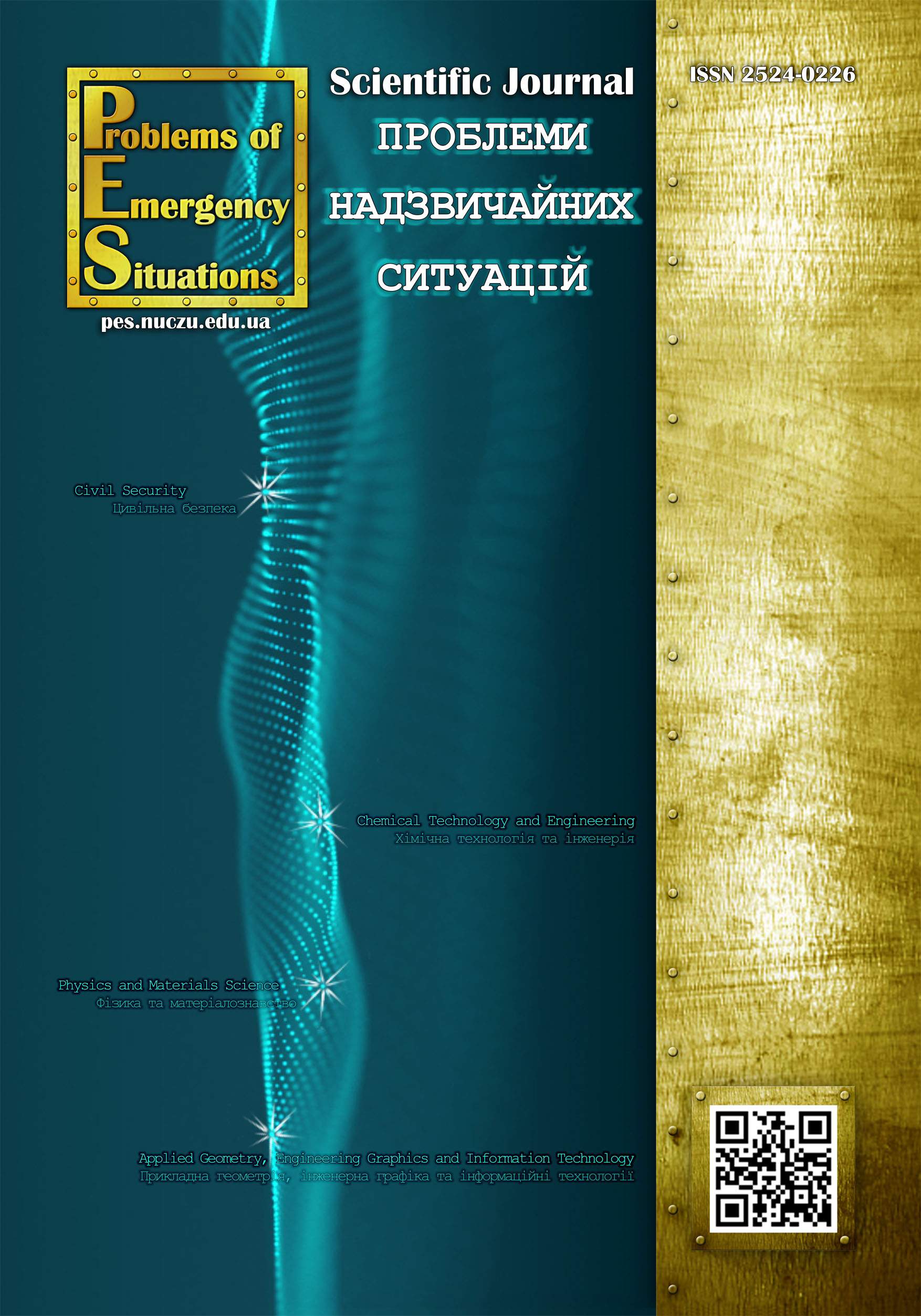Development of the mathematical model of the magneto-contact thermal fire alarm
Durieiev Viacheslav
National University of Civil Protection of Ukraine
https://orcid.org/0000-0002-7981-6779
Khrystych Valerii
National University of Civil Protection of Ukraine
http://orcid.org/0000-0002-5900-7042
Bondarenko Serhiy
National University of Civil Protection of Ukraine
http://orcid.org/0000-0002-4687-1763
Antoshkin Oleksiy
National University of Civil Protection of Ukraine
http://orcid.org/0000-0003-2481-2030
Maliarov Murat
National University of Civil Protection of Ukraine
http://orcid.org/0000-0002-4052-7128
DOI: https://doi.org/10.52363/2524-0226-2024-40-1
Keywords: fire detector, sensitive element, mathematical model, inertia, activation time, activation temperature
Аnnotation
Mathematical models of a fire detector have been developed taking into account the dependence of the magnetization of the contacts of the sensitive element on the temperature and the parameters of the contact material. The obtained equations of the dynamics of the SP take into account the type and structure of the materials of the contact elements of the ЧЭ and the dependence of their magnetization on the temperature and correspond to the inertial positional link of the first order, written in relative variables with constant coefficients. As a result of studying the current literature, the characteristics of the material of the magnetic contacts have been taken into account in the models to determine its optimal dynamic parameters. The mathematical model of the detector is a system of equations consisting of the heat balance equation under conditions of non-stationary heat exchange with the assumption of uniform heating of the contacts of the sensitive element over the entire depth. The second is the equation of the relationship between the magnetization of contacts soldered in a reed switch and temperature. The obtained detector dynamics equations take into account the type and structure of the materials of the contact elements and the dependence of their magnetization on temperature and correspond to the inertial positional link of the first order. The variables of the equations are relative to the linearization point, with constant coefficients. The equations allow to study the detector operation parameters with the principle of the dependence of magnetic induction on temperature. The dynamics equations allow to study the dynamic parameters of the operation of thermal fire detectors, the relative error of the results does not exceed 5 %. The obtained results of the simulation of the fire detector operation confirm the correctness of the chosen hypothesis, and the determined parameters of the fire detector operation coincide with the experimental data. The results of the conducted studies allow to provide recommendations on the selection of the detector operation parameters, which will improve the quality of their operation: static and dynamic operation temperatures, inertia, operation time.
References
- Abramov, Y., Basmanov, O., Salamov, J., Mikhayluk, A. (2018). Model of thermal effect of fire within a dike on the oil tank. Naukovyi Visnyk Natsionalnoho Hirnychoho Universytetu, 2, 95–100. doi: 10.29202/nvngu/2018-2/12
- Lu, H., Zhu, Y., Hui, J. G. (2007). Measurement and modeling of thermal effects on magnetic hysteresis of soft ferrites. IEEE Transactions on Magnetics, 43(11), 3953–3960. doi: 10.1109/tmag.2007.904942
- Kachniarz, М., Salach, J, Szewczyk, R., Bieńkowski, A., Korobiichuk, I. (2015). Investigation of temperature effect on magnetic characteristics of manganese-zinc ferrites. Eastern-European Journal of Enterprise Technologies, 6/5(78), 17–21. doi: 10.15587/1729-4061.2015.55410
- Martinson, K., Belyak, V., Sakhno, D., Chebanenko, M., Panteleev, I. (2022). Mn-Zn Ferrite Nanoparticles by Calcining Amorphous Products of Solution Combustion Synthesis: Preparation and Magnetic Behavior. International Journal of Self-Propagating High-Temperature Synthesis, 31, 17–23. doi: 10.3103/S106138622201006X
- Nairan, A., Khan, M., Khan, U., Iqbal, M., Riaz, S., Naseem, S. (2016). Temperature-Dependent Magnetic Response of Antiferromagnetic Doping in Cobalt Ferrite Nanostructures. Nanomaterials, 73. doi: 10.3390/nano6040073
- Thanh, T. D., Manh, D. H., Phuc, N. X. (2015). Deviation from Bloch’s T3/2 Law and Spin-Glass-Like Behavior in La0.7Ca0.3MnO3 Nanoparticles. J Supercond Nov Magn 28, 1051–1054. doi: 10.1007/s10948-014-2869-5
- Samir, U., Firoz, U., Momin, A., Hakim, M. (2021). Effect of V2O5 addition on the structural and magnetic properties of Ni–Co–Zn ferrites. Published by IOP Publishing Ltd. doi: 10.1088/2053-1591/abd865
- Mahmoudi, M., Kavanlouei, М. (2015). Temperature and frequency dependence of electromagnetic properties of sintering Li–Zn ferrites with nano SiO2 additivet. Journal of Magnetism and Magnetic Materials, 384, 276–283. doi: 10.1016/j.jmmm.2015.02.053
- Jackiewicz, D., Szewczyk, R., Salach, J. (2013). Modelling the magnetic characteristics and temperature influence on constructional steels. Solid State Phenomena, 199, 466–471. doi: 10.4028/www.scientific.net/ssp.199.466
- Cojocaru, S. (2011). Magnon gas and deviation from the Bloch law in a nanoscale Heisenberg ferromagnet. Philosophical Magazine, 1–15. Available at: https://www.researchgate.net/publication/233077658_Magnon_gas_and_deviation_from_the_Bloch_law_in_a_nanoscale_Heisenberg_ferromagnet
- Durieiev, V. O., Khrystych, V. V., Bondarenko, S. M., Maliarov, M. V., Korniienko, R. V. (2023). Matematychna model mahnitnokontaktnoho teplovoho pozhezhnoho spovishchuvacha. Problemy nadzvychainykh sytuatsii, 1(37), 31–43. Available at: http://pes.nuczu.edu.ua/images/arhiv/37/3.pdf ISSN 2524-0226
- Zabara, S. (2015). Modelyuvannya sistem u seredovishchі MATLAB. Unіversitet Ukraїna, 137. Available at: https://www.yakaboo.ua/modeljuvannja-sistem-u-seredovischi-matlab.html














